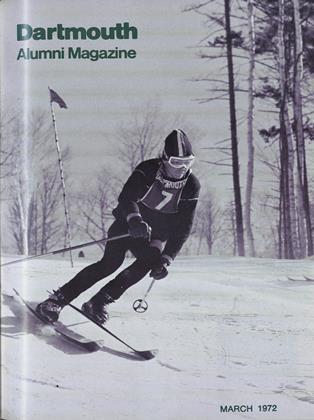By Thomas B. Curtis '32 and John RobertVastine Jr. New York: Praeger Publishers1971. 239 pp. with charts, tables, andappendix. $17.50.
The proposition that free trade provides more economic welfare than does no trade is well known; nevertheless, international trade has never been completely free. Why is it that the political process can't be counted upon to bring about free trade when the latter would appear to be in everybody's interest? The answer lies in the fact that a significant redistribution of income takes place whenever impediments to trade are removed. If a country eliminates tariffs on imports, wages and profits tend to rise in exporting industries and fall in those industries which compete with the imports. Everyone as a consumer stands to benefit from the cheaper imports; and that, of course, is the real gain to a country from freer trade. Unfortunately, however, the consumer interest tends to be poorly represented in the political process because benefits are widely diffused and not readily measured. Therefore, the most effective strategy for achieving free trade is one of combatting the pressures from industries competing with imports by rallying behind the opposing interests of exporters.
Just such a strategy underlies the U.S. reciprocal trade policy, which was initiated by the Roosevelt administration in 1934, at a time when the average tariff rate on imports into the U. S. was over 50% and tariff rates abroad were equally high. Under reciprocal trade policy, we stand ready to reduce our own barriers to trade only so long as we receive offers of roughly equivalent concessions from our trading partners that will be of direct benefit to our own exporters. This policy has been so successful in coalescing support for freer trade that U. S. tariff rates had fallen to an average of only about 14% by the beginning of the 1960's. At that time, the European Common Market was created, and its potential threat to the future growth of U. S. exports helped to provide the impetus for a further round of reciprocal trade liberalization.
The Kennedy Round and the Future ofAmerican Trade is about this most recent episode in the history of our reciprocal trade negotiations. Thomas B. Curtis served as one of the Congressional delegates to the long and complex series of negotiations, which lasted from 1962 until 1967, and John Robert Vastine Jr. was his economic assistant. This book is based upon their detailed and informative reports to Congress on the progress of the negotiations and the major issues involved. It makes a unique and valuable contribution to the current literature by weaving together the legal and economic aspects of the negotiations, though it is definitely directed at the specialist rather than the general reader. "
A major conclusion of the book is that the Kennedy Round of negotiations, even though successful in making substantial tariff cuts, left virtually untouched many nontariff barriers to trade. Among the most important of these are special restrictions on trade in agricultural goods which are the outward manifestations of domestic farm programs; so-called "voluntary" quotas on certain exports of foreign goods into the U. S., which were begun in textiles and have since spread to steel and a number of other products; and other nontariff barriers such as customs valuation methods which effectively raise duties, discriminatory government buying rules, and trade barriers caused by differences in domestic tax systems. Although the Kennedy Round made it clear that it is vastly more difficult to negotiate the removal of most such nontariff barriers than it is ordinary tariffs, Curtis and Vastine emphasize that the attempt should be made.
A Dartmouth Assistant Professor of Economics,Mr. Throop specializes in InternationalEconomics and Money and Banking.
 View Full Issue
View Full Issue
More From This Issue
-
 Feature
FeatureFinancing Higher Education
March 1972 By John G. Kemeny -
 Feature
Feature"Fraternities Are in Trouble"
March 1972 By DAVID WRIGHT '72 -
 Feature
FeaturePilobolus: Energetic Dance-Theater
March 1972 By ANDREW W. CASSEL '72 -
 Feature
FeatureDartmouth Institute Plans First Session
March 1972 By M.R. -
 Article
ArticleFaculty
March 1972 By ROBERT B. GRAHAM '40 -
 Class Notes
Class Notes1950
March 1972 By JACQUES HARLOW, ERIC T. MILLER
Article
-
 Article
ArticleDefense Group Galls for No Compromise
November 1941 -
 Article
ArticleCallihan Scholarship
February 1951 -
 Article
ArticleFreshman Fathers Weekend
MARCH 1970 -
 Article
ArticleHockey: So Very Close
April 1979 -
 Article
ArticleThe Distinguished Young Alumni Awards
SEPTEMBER 1991 -
 Article
ArticleYankee Inn Keeper
MARCH 1969 By HAL BRAMAN '21


